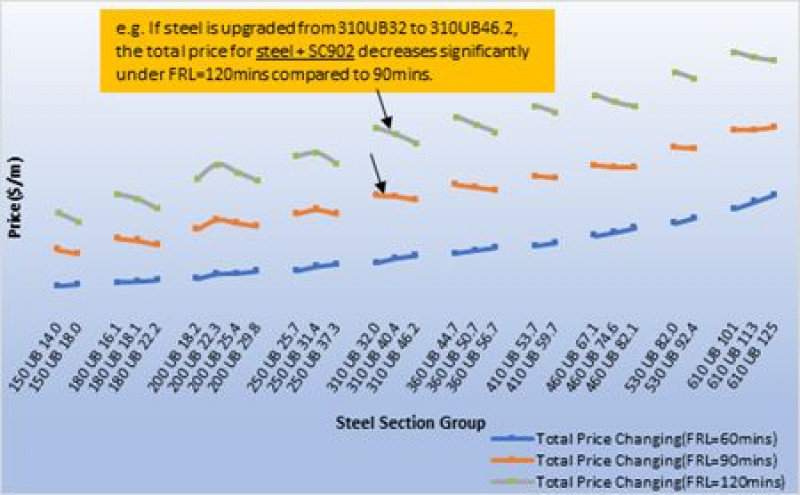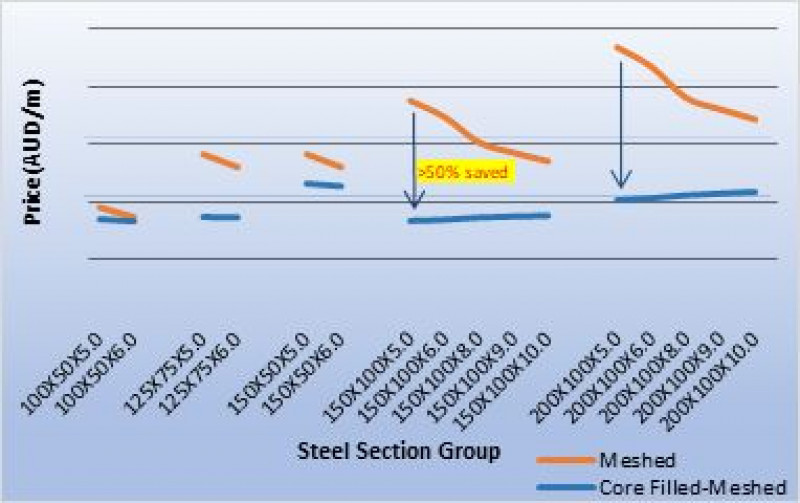-
Australia
Copyright © 2025 Powered by BCI Media Group Pty Ltd
Confirm Submission
Are you sure want to adding all Products to your Library?
Contact Detail

In the same way a structure is designed for strength, robustness and serviceability, it is equally imperative – yet often overlooked – that it is designed to withstand the heat of a fire. Heat, Fuel and Oxygen are three main components involved in a burning fire, with the type of fuel burning determining how the fire is classified. Cellulosic fires being those common to commercial and residential buildings and Hydrocarbon fires being those which are fuelled by combustible liquids such as petrol, diesel, heptane, cyclohexane and benzenes.
Intumescent fire protection is an effective passive fire protection method that delays the heat of a fire directly entering into structural steel members thereby maintaining its structural adequacy for longer and giving occupants time to get out and fire services time to get in and fight the fire.
As often as not with construction, a primary consideration is price, thus, price optimisation involves customising steel selection on a steel frame building so that the reduction in passive fire protection cost is far greater than the cost to increase the weight of steel to achieve similar outcomes. However, as a newer field of speciality in the overall construction industry, much remains unknown or misunderstood with regards to how to apply fire protection and indeed, how much is required for both optimal performance at an optimal price. The context of this piece is to prove the benefits of conscious steel selection with fire rating in mind.
How Price Optimisation Works
For the purposes of this paper we make two assertions: analysis is based on standard steel sections used in the Australian steel structure market and the product applied is Nullifire SC902 hybrid intumescent coating. A unit price can be generated in two ways: per linear meter and per square meter depending on the different measurement models. Similarly, the cost of the required fire-rated structural sections consists of two parts:
Due to factors such as on-site conditions, project location and required level of finish, specific intumescent costs will vary from project to project. Therefore the results of optimisation will vary project to project, and for the purposes of this analysis have been shown qualitatively.
Passive Fire Protection Quantity Calculation
The following three factors or design variables determine the amount of fire protection required on a structural steel member;
Where the critical steel temperature corresponds with the load ratio (rf) on the steel and is determined based on AS4100 the following load ratio and critical steel temperature values are commonly used:
Steel sections which have a higher Hp/A have a faster heating rate, while lower Hp/A’s have a lower heating rate. This results in heavier sections requiring less intumescent to achieve the required Fire Rating Level (FRL) while conversely, lighter steel sections require more product.
Thin, hollow steel sections often prove to be a paradox. In many cases they have high Hp/A’s and require core filling to reach the desired FRL. At other times, core filling may not be required, but can be used as an effective means to reduce the overall costs associated with achieving the desired fire rating protection.
For hollow sections, core-filling columns is an effective way of significantly reducing the required SC902 thickness. By core-filling the column an effective Hp/A can be used so that certain hollow sections can achieve a higher FRL. Further information on this can be found in the Permax Core-filling Technical Advisory Note which can be requested.
Determining the optimal amounts of intumescent required requires complex calculations and consideration to aspects of the overall project. In most cases, working with qualified engineers who understand these complexities will lead to substantial project savings, albeit, those with the expertise are limited in number. As such, other tools such as the Permax optimisation Calculator have been developed to assist in project specification and to provide insight into cost-saving options.
Structural Steel Selection
To achieve an optimised solution, structural analysis of the members is required before the steel is fabricated. The aim of this analysis is to determine if it is possible to increase certain steel sections in order to reduce the overall quantity of fire protection needed. The trade-off is between;
Time spent at the design stage selecting steel to optimise fire protection.
Vs.
Cost savings of upgrading the steel and reducing total intumescent quantity.
In certain project scenarios it may not be possible for engineers to change the selection of steel due to factors such as load restrictions on foundations. As a result, anecdotal evidence points to the benefits of project planning early in the design process so as to best identify how to achieve adequate FRLs at an optimal cost.
Process Of Optimisation
The process of optimisation has several guiding parameters. Understanding the decision variables, objective function and constraints as illustrated below, can provide structure and allow objective analysis as regards the optimisation process.

The method used to determine the total cost is a combination of the following:
Increased Price of Steel

Decreased Price of SC902.

Where β represents the specific gravity of the intumescent used to calculate the total quantities.
An optimisation calculator such as the one developed by Permax, generates the total cost for steel and SC902 intumescent coating based on the above and resturns results against FRL’s for different steel section groups. The analysis applies to the following types of steel used as structural members:
Case Study For The Universal Beam
An example estimation has been carried out for 3-sided universal beams supporting a concrete floor load with a critical steel temperature of 620C. The aim of this case study is to show where the benefits of optimising a steel selection with fire rating can bring savings across projects. The general theory is that price for steel increases as the member size is increased whilst conversely, the price for intumescent falls as the quantity of intumescent required is reduced with due to increased steel size. The graph below shows the total price for steel and SC902 fire protection of each universal beam member size for a 60, 90 and 120 minute FRL.
Universal Beam Trend in Total Cost (3-Side-Exposed Beam Section; 620℃ Critical Steel Temperature)

The blue line represents the total cost under a 60 minute FRL. Under these parameters, it becomes evident that there is no cost benefit achieved by increasing the weight of steel to reduce the cost of fire protection for steel requiring a 60 FRL. By compsrison, under 90 and 120 minute FRL’s the results are vastly different. this trend is vastly different for a 90 and 120 minute FRL.
The Dry Film Thickness (DFT) of product required for a 90 FRL can be more than 3 times the DFT for a 60 minute FRL, which explains the change in trend for higher FRL’s. It is visible from this case study that there can be significant SC902 fire protection cost savings made by increasing the size of universal beam sections across a project.
Case Study For Rectangular Hollow Section
An additional analysis has been conducted on Rectangular Hollow Sections (RHS) to understand the cost benefits of core-filling a hollow section to increase its fire performance. The graph below is calculated based on the cost of steel, cost of intumescent as well as the cost for core-filling a 4-sided exposed column. From the analysis it is evident the project cost can be lowered significantly whenever core filling is involved. This is due to the effective core-filled HP/A reducing the required DFT of the hollow section member.
Price Comparison between different procedures for RHS under FRL=90mins
(4-SidedExposed Column Section; 550℃ Critical Steel Temperature)

Per the graph, it is estimated that a greater than 50% saving can be achieved through core filling the listed steel sections. The added advantage is that core-filling is not only a cost-effective fire rating procedure, but it increases the structural load-bearing capacity of the column.
In Conclusion: Permax Are Here To Help
With a team spanning the East Coast of Australia, Permax are not only well placed to assist you with your fire rating requirements, but also have multiple engineers trained in the fire engineering. Our strong and comprehensive technical background, coupled with our access to Nullifire’s range of thin film intumescents gives us the ability to offer the most cost-effective solutions for each project – irrespective of where in Australia it may be.
The Nullifire SC902 intumescent coating system is a high standard passive fire protection system, providing aesthetics, productivity and tested fire performance.
Our focus on assisting you with specifications, technical advisory notes and advice on design details is only part of our service. We aim to help each and every client to optimise the costs of fire rating on their project and will provide the advice enabling you to do that.



